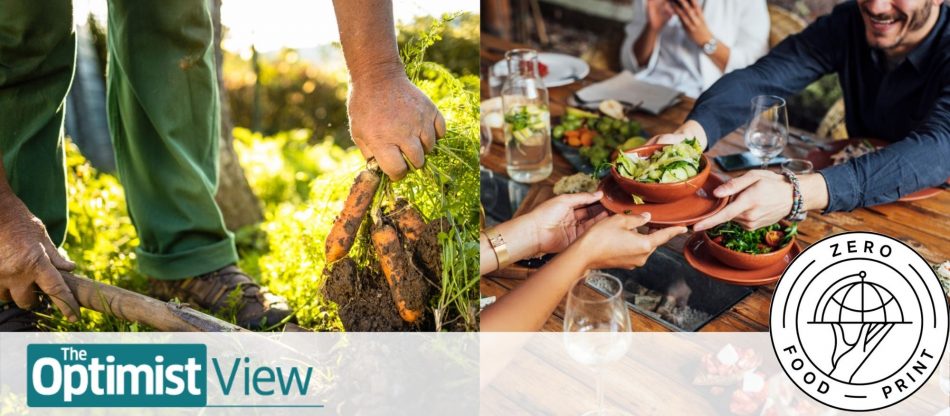“Since the goal is to truly change many acres of farmland, then we must not only try to source well, but specifically ask our existing supply chains to change. In fact, we should help pay for the transition.” – Anthony Myint, Zero Foodprint
BY Amelia Buckley
If you visit the famous Chez Panisse restaurant in Berkeley, California, you might enjoy a delicious asparagus salad with gold beets and fennel. You might also notice a small one percent charge on your bill to support regenerative agriculture. Chez Panisse is one of over 60 restaurants partnered with Zero Foodprint to fund agricultural climate solutions one meal at a time.
Started by Anthony Myint and Karen Leibowitz, Zero Foodprint is based on what they call a “table-to-farm” model. The organization takes a few cents from participating restaurants’ meals and uses them to fund regenerative agriculture grants for farms.

Myint and Leibowitz weren’t always involved in the regenerative agriculture industry. The pair of chefs initially founded San Francisco restaurant Mission Chinese Food. After receiving New York Times Restaurant of the year in 2012, the pair welcomed their first child and started to think more critically about the threat of climate change in our world. Together, they founded a second restaurant, The Perennial, aiming to source ingredients from the most sustainable distributors possible, but quickly realized that their efforts had to go further to make a tangible climate impact.
Scaling up sustainability
Despite 50 years of advocacy from nutritionists and sustainable farmers, organic farming still only makes up about two percent of global farmland. Discouraged by this reality, Myint was determined to come up with a strategy to accelerate the adoption of carbon-capturing regenerative agriculture. With that goal in mind, Zero Foodprint was born.
Since 2016, Zero Foodprint has awarded $325,000 in grants to 18 carbon farming projects to remove 7,000 tons of carbon from the atmosphere. The organization kickstarted their work with money from a USDA Conservation Innovation Grant, but Myint emphasizes that their work is not charity, but rather a tactical solution for moving the food system towards a greener future: “This is a systematic approach to improve land stewardship.”
So why regenerative agriculture? Solutions for climate change mitigation often focus on electric vehicles or complex carbon capture schemes, but in Myint’s own words, “The solution to reducing carbon emissions is not using chard stems or perfecting the stem cell burger.” While these flashier technologies play an important role in achieving a net-zero carbon future, one of the most powerful tools for carbon capture already exists right below our feet. According to the Intergovernmental Panel on Climate Change (IPCC) and Global Carbon Project, every dollar invested in regenerative agriculture provides $40 in improved resilience, water conservation, farmer prosperity, and carbon removal.
Regenerative agriculture practices include planting diverse crops and utilizing cover crops to improve soil  health. It also means not using tilling or plowing to turn over soil, but rather employing composting and managed grazing to revitalize fields. This process essentially takes “bad carbon” from the atmosphere and turns it into “good carbon” in the form of nutrient rich soil. This soil is full of microbes, fungi, and bugs which thrive alongside healthy plants. These farms also emphasize a healthy working environment with job security and a livable wage for employees.
health. It also means not using tilling or plowing to turn over soil, but rather employing composting and managed grazing to revitalize fields. This process essentially takes “bad carbon” from the atmosphere and turns it into “good carbon” in the form of nutrient rich soil. This soil is full of microbes, fungi, and bugs which thrive alongside healthy plants. These farms also emphasize a healthy working environment with job security and a livable wage for employees.
So why doesn’t everyone opt for regenerative? For one thing, it’s more expensive. Although the benefits eventually outweigh the costs, it takes more effort and initial investment to revitalize land naturally. Plus, regenerative farmers do not qualify for government subsidies, which many farmers rely on to stay afloat. On average, conventional farmers lose $60 per acre before subsidies and only make $20 per acre after subsidies, essentially setting up a zero sum game in which the vitality of big agriculture is prioritized at the expense of the planet and farmers using best practices.
This policy becomes even more counterproductive when you consider that according to Ohio State University researchers, a mere two percent increase in the carbon content of the planet’s soils could offset all greenhouse gas emissions going into the atmosphere.
Featured Project: McCauley Family Farm
One farm using Zero Foodprint to transition to regenerative practices is McCauley Family Farm in Longmont, Colorado. Run by Marcus McCauley, the farm rotates pigs, chickens, and sheep in a grazing cycle throughout their land to rejuvenate the soil, and uses composting to reduce food waste by turning scraps into organic fertilizer. McCauley Family Farm is on a mission to “heal people and the planet with delicious food.” They have expanded to help restore more degraded rangeland throughout the state and are using new funds to plant a multi-function forest windbreak to reduce erosion and sequester even more carbon.
“Healthy soil grows the most nutrient dense and delicious food possible. It also happens to sequester carbon and have a major impact on climate change,” says McCauley.
Zero Foodprint uses the USDA’s Comet Planner tool to assess the carbon capture benefits of certain regenerative agriculture projects. The organization compares projected carbon capture and cost of project implementation to calculate a cost-benefit analysis of prospective farms. This figure helps them allocate funds to initiatives with the most bang for their buck in terms of carbon capture.
Myint says that Zero Foodprint is happy to support candidates in all stages of regenerative practice adoption, “whether it’s a conventional farmer taking their first step or a regenerative farmer taking their ninth step.”
Getting consumers involved
In addition to carbon sequestration benefits, Myint points out that Zero Foodprint’s value also lies in its ability to give customers a sense of climate autonomy. Driving across town to buy organic tomatoes from the farmer’s market can be too expensive and time consuming for some families, but patronizing a restaurant where a portion of profits is automatically going towards regenerative agriculture is simple and rewarding. Myint says, “Zero Footprint is giving consumers what they want: a way to take direct climate action at a low cost.”
 The concept of reaping mass benefits from small widespread changes, also called community choice aggregation, turns the collective action dilemma on its head by making every purchase part of the climate solution. If pledges from 50 or 100 restaurants can make an impact, imagine the agricultural revolution that could transpire if every restaurant in the country partook in Zero Foodprint.
The concept of reaping mass benefits from small widespread changes, also called community choice aggregation, turns the collective action dilemma on its head by making every purchase part of the climate solution. If pledges from 50 or 100 restaurants can make an impact, imagine the agricultural revolution that could transpire if every restaurant in the country partook in Zero Foodprint.
This idea has already crossed Myint’s mind. His team has crafted potential legislation that could mandate regenerative agriculture funding participation from all restaurants, much like a fee for plastic bags or the employee health surcharges employed by some San Francisco restaurants. Zero Foodprint is working with California legislators to ask all restaurants to add an optional surcharge to their menus. If just one percent of California’s restaurants participated in the program, they could generate $10 million a year to fund regenerative farming projects.
Myint acknowledges that leaning on restaurants to help fund climate solutions during a global pandemic has been no easy feat. Many restaurants have faced their most trying times yet over the past year, but he says there is an upside in the fact that the pandemic has given us a “greater sense that things can change and it will be okay.”
As restaurants start to bounce back, many customers have a heightened sense of what really matters and a vivid image of what can go wrong when we ignore the implications of climate change. “There’s really no downside to investing in better farming and healthy soil, which also creates more delicious and nutritious food while conserving water and making farms more climate resilient,” says Myint.
Want to support Zero Foodprint? You can find participating restaurants here or donate directly to a regenerative agriculture project on their website. If you know a restaurant owner or chef who is passionate about reducing their carbon footprint, you can encourage them to sign up for Zero Foodprint’s initiative.












